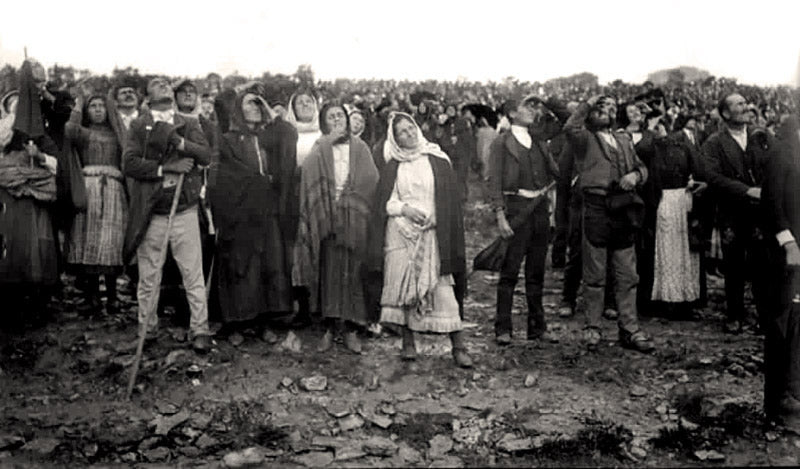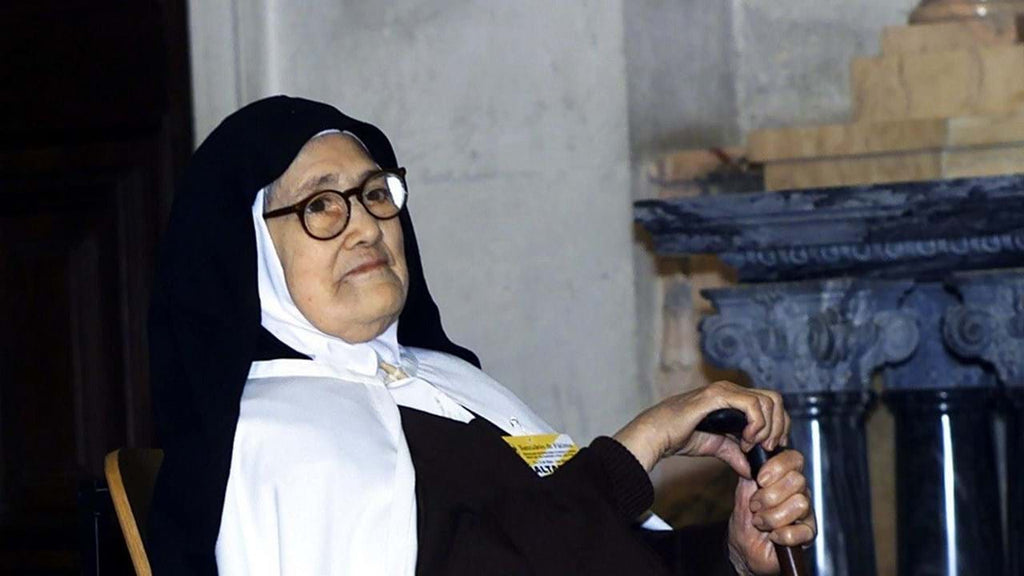
Valentine's Day and Lenços dos Namorados
In Portugal, Valentine's Day has a special significance, combining age-old traditions with modern elements, and is closely associated with the famous Lenços dos Namorados...
Fátima is a small Portuguese town located between Lisbon and Porto, about 40 km from the Atlantic Ocean. This small village suddenly became famous in 1917, when three young shepherds claimed that the Virgin Mary had appeared to them.
In fact, it is a succession of events that affected that year 1917 in Fátima and that are at the origin of one of the greatest places of Catholic pilgrimage today.
On May 13, 1917, three young shepherds between 7 and 10 years old returned from the fields outside the hamlet of Aljustrel and claimed to have seen a Lady dressed in white.
This "Lady" would have asked them to recite the rosary every day to obtain peace in the world and the end of the war and then to return to the same place, at the same time on the 13th of the following month.

The news spread quickly and this apparition was very quickly associated with the Virgin Mary, but there were many skeptics, both among the population and the clergy, who took a dim view of this apparition.
On June 13, 1917, the children were at the rendezvous accompanied by 50 curious people who wanted to see the phenomenon. The Virgin Mary appeared again to the children, recommended devotion to the "Immaculate Heart of Mary", announced the imminent death of two of them and asked one of them to learn to read and write in order to better carry her word to men.
The 3 children are the only ones to perceive the apparition, none of the 50 people present will notice any phenomenon.
On July 13, 1917, the children were again present, this time accompanied by more than 2,000 people. The 3 children were always alone in perceiving the apparition, only a few people present admitted to having noticed the presence of a small white cloud above the apparition site.
On August 13, 1917, it is, this time, more than 5,000 people who are at the rendezvous near what is now called the oak of the apparitions. But the children were not there, they had been taken to Ourèm for interrogation and then locked up for disturbing the peace.
This time, the people present noticed unexplained meteorological phenomena: luminous lightning and a cloud that was positioned on the oak tree where the apparitions were taking place. Under the pressure of the crowd, the 3 children are released and the Virgin will appear to them on August 19th promising them again a miracle for October 13th.

On September 13, 1917, more than 10,000 people were present at the oak tree during the apparitions and, once again, the same meteorological phenomena were observed. The Virgin repeated her promise of a miracle on October 13.
On October 13, 1917, a compact crowd of more than 50,000 people crowded near what remained of the apparition oak tree, which had been stripped to make relics. The three children arrived at the site on a rainy day and one of the children asked the crowd to close their umbrellas in spite of the downpour.

The miracle of the sun, that day, will be the subject of a quantity of press articles often very critical or ironic and at best reserved and cautious.
This was a time of repression for civil society and the political world, which went so far as to ban all pilgrimages to Fatima, and a time of investigation for the religious world and the clergy, which led to the official recognition of the apparitions of Fatima and the approval of the cult of Our Lady of Fatima on 13 October 1930.
It was during the third apparition, on July 13, 1917, that Our Lady revealed the three parts of the secret of Fatima to the three children, asking them at the same time not to reveal them immediately.
Lucia (Lúcia dos Santos), the holder of the secret, revealed the first two parts publicly in 1941 on the occasion of the publication of her Memoir on the apparitions. The third part was written on a letter in 1944, given to the bishop of Leiria (Portugal) and then transmitted to the Vatican's secret archives in 1957 after Lucia's approval and the commitment not to open it before 1960. It was not publicly revealed until 2000.
It is this third part and the secrecy surrounding it that will give rise to all the suppositions, fantasies and elucidations. So what about it?
In fact, these three parts of the same revelation remain rather obscure and require interpretation. These interpretations have been numerous, often different and sometimes contested.
The first part of the secret of Fátima was a revelation of a horrible vision of hell with a supplication that could be translated as :
"You have seen the hell to which the souls of poor sinners go. To save them, God wants to establish in the world devotion to my Immaculate Heart. If we do what I am going to tell you, many souls will be saved and there will be peace "
The second part of the secret of Fatima concerns Russia and its consecration to the Immaculate Heart of Mary and a warning that could be translated as follows:
"If my requests are accepted, Russia will be converted and we will have peace. If not, she will spread her errors throughout the world, provoking wars and persecutions against the Church. The good ones will be martyred, the Holy Father will have much to suffer, various nations will be destroyed. In the end, my Immaculate Heart will triumph. The Holy Father will consecrate Russia to me and it will be converted, and the world will be granted a certain time of peace. ".
The third part of the secret of Fátima is presented as a disturbing allegorical vision :
"We saw various other bishops, priests, religious men and women climb a steep mountain, on top of which there was a large cross made of rough trunks, as if they were made of cork oak with their bark; before reaching it, the Holy Father passed through a large city half in ruins and, half trembling, with a wavering step, afflicted with suffering and pain, he prayed for the souls of the corpses he found on his way; When he reached the top of the mountain, prostrated on his knees at the foot of the great cross, he was killed by a group of soldiers who fired several shots with a gun and arrows; and in the same way bishops and priests, religious men and women and various laymen and women of different classes and social categories died one after the other ."
If the first 2 parts, in spite of many different interpretations, did not pose any problem, it is not the same for the 3rd part.
The controversies are numerous and concern the authenticity of the message unveiled by the Vatican, the completeness of the message made public, whether it is outdated or not, its different interpretations, and even the existence of a fourth part.
The children, witnesses of the apparitions of the Virgin, were 3: Lúcia de Jesus dos Santos and her 2 cousins: Francisco Marto and Jacinta Marto. In fact, only Lúcia sees and hears the Virgin and dialogues with her. Jacinta sees and hears their words but does not dialogue, while Francisco sees without hearing. In the second apparition, on June 13, 1917, Our Lady announced to Lúcia that her cousins would soon die.
Jacinta was struck by the Spanish flu in December 1918. She died alone in a Lisbon hospital on February 20, 1920, at the age of 9, after long suffering from pleurisy and not being able to be anaesthetized because of heart problems.
She will be canonized on May 13, 2017 in Fatima, by Pope Francis, on the occasion of the centenary of the apparitions and after Pope John Paul 2 said of her that she offered herself heroically as a victim for the conversion of sinners.
After being buried in the cemetery of Vila Nova d'Ourém, her remains were moved several times before being transferred to the Basilica of Fátima.

Francisco was also stricken by the Spanish flu in December 1918. He died on April 4, 1919, at the age of 10, after several relapses and remissions without ever having stopped reciting several rosaries a day.
IHe was buried in the parish cemetery without his sister, too weak, being able to attend the funeral. In 1952 his remains will be transferred to the Basilica of Fátima and he will be canonized, along with his sister, on May 13, 2017 in Fatima, by Pope Francis.

Lúcia is the only one of the 3 shepherds who declared to have seen and heard the Virgin and to have spoken with her in 1917. In 1921, she began to receive a religious education in Porto and then entered the Convent of Tui in Spain and took her vows in 1934 and received the name of Sister Maria das Dores (Mary of Sorrows).
In 1948, she returned to Portugal and entered the Carmelite convent of Saint Teresa in Coimbra where she remained until her death in 2005 at the age of 97.

In 2017, the diocesan investigation for her beatification was forwarded to Rome, which is awaiting official recognition of a miracle to complete the beatification process.
Before 1917, Fátima was just another village in central Portugal. After the apparitions of the Virgin Mary, Fátima immediately became a place of pilgrimage.
The chapel of the apparitions was built by the inhabitants of the town as early as 1919 and the construction of an accommodation for pilgrims was undertaken in 1921.

It was not until 1927 and the beginning of the recognition of the events of Fatima by the Church that the cult of Our Lady of Fatima was officially authorized and the construction of a sanctuary and a church (the Church of Lady of the Rosary) was decided upon.
Today, more than 5 million pilgrims set out on foot from the various towns and villages of Portugal and arrive at the sanctuary after several days of walking.

The 3 main current facilities are the esplanade, the colonnade that surrounds the Basilica of Lady of the Rosary

Esplanade Fátima


But there is also the Basilica of the Holy Trinity inaugurated in 2007 which is the 4th largest Catholic church in the world.

Le message de Notre Dame du Rosaire est le méme que celui donné par Notre Dame de tous les Peuples à Akita à soeur Agnès Sasagawa le 13 octobre 1973 pour ce qui concerne la nécessité pour l’humanité de revenir à Dieu et de faire pénitence. Le message est toujours d’actualité.
In Portugal, Valentine's Day has a special significance, combining age-old traditions with modern elements, and is closely associated with the famous Lenços dos Namorados...
Barbotine, which fell into disgrace in the 20th century, is enjoying a captivating renaissance at the crossroads of ancestral techniques and modern creativity.
Curious about Portugal and its history? Take 5 minutes to read our blog post!


